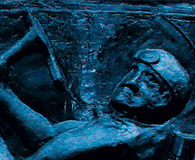On the morning of October 14, 1913, shortly after the 950 men on the morning shift had descended the pit, a horrendous blast sent the two-ton cage rocketing skyward, destroying the pithead. Fire and explosion swiftly spread through the districts of the West side of the mine. Dreaded methane gas fueled the conflagration, though the exact cause of the explosion was never determined.
Though the narrative has been fully told and carefully recorded, it is difficult to imagine the immediate aftermath of that morning blast. From the East side of the mine, the men were brought safely to the surface. Those working the larger districts to the West, however, were doomed to rock falls, fire and suffocation. Along the dingy terraced blocks of Senghenydd and Abertridwr, women lost their fathers and their brothers, their husbands and their sons.
The fires underground were still raging six days later, when the official death toll was stated to be 439. More than 30 bodies had yet to be recovered. The Universal Colliery explosion remains the worst mining disaster in British history, and one of the worst ever in the world. This time, the toll included 205 widowed women, 542 children left without fathers and 62 dependent parents bereft. Senghenydd’s grief can not be fathomed.
There was no money in the Aber Valley, and no burial ground in its shallow soil. Coffins were hand carried by their comrades more than four miles up the mountain above Abertridwr to the churchyard of Eglwysilan. Six surviving miners bore each body, while six filed behind in relief. The graveyard could not contain them all, and another ground was opened in Penyrheol on the outskirts of Caerphilly. They lie in both cemeteries, row on row.
Today the mine shafts have been filled and capped; colliery buildings have been cleared away or adapted to other uses. The Nant-y-parc primary school sits on the site of the Universal pit head. Just outside its gates, a poignant memorial remembers what is often known simply as the Senghenydd Explosion.
At the village hall, a Heritage Room, open to the public and staffed by volunteers, tells the story of Britain’s greatest mining disaster. I visited there with 89-year-old Penry Evans, whose memories of the explosion’s aftermath are fresh.
As he has for years, Evans sits on “the Committee” that guards the memory and commemorations of the Senghenydd Explosion. They are already preparing to remember the centenary of the disaster in 2013, but Evans is concerned for the future. “It’s so difficult to find young people who want to take an interest,” he laments. “They’re all too busy with television and video games. On the committee, we’re all old. Who’s going to remember when we’re gone?”
Across the street at the Aber and Senghenydd Ex-Servicemen’s Club, the second floor is the club room and rehearsal hall of the Aber Valley Male Voice Choir—one of the best in Wales. Wednesdays and Sundays, the men drift in to rehearse, picking up their pints of beer at the bar on their way upstairs. Every year at a memorial service the choir sings the beautiful lament written to commemorate Senghenydd’s tragedies: “Rest, Sad Heart, Rest.”
This night I sat in to sing with them:
Thanks be to God for roses red
For skies of blue and sunshine fair
For every gift I raise a prayer:
Thanks be to God.
To Remember the Valley
The full story of the Senghenydd disasters is movingly told in The Valley of the Shadow by John H. Brown, Alun Books, Port Talbot, 176 pages, softcover, £10. Originally published in 1981, the book was reissued in 2009.
Caerphilly is a fine base for a visit to Senghenydd, with many lodging and dining options (as well as the largest castle in Wales). Follow the B4263 north into the Aber Valley. In addition to Senghenydd, visit the memorial in Abertridwr to the scores of men who perished over the years at the Windsor Colliery.
